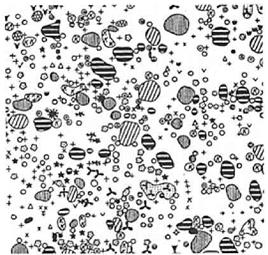Much naturalistic planting design is an abstraction of the patterns and groupings of plants to be found in wild or semi-natural vegetation. Although drift planting can achieve some of this effect if repeated over a sufficiently large area (as shown in Figure 9.5), there is a fundamental problem to this style that leaves many ecologically-minded designers less than satisfied: plants are growing in distinct groups with very little interactions between those groups. This is very different to the more natural situation where there is much greater merging between stands of different species, and where many species may not occur in well-defined groups at all. To many people it is the very intimate mixing of compatible species at the smaller scale that grades up into recognisable patterns at the larger scale that is particularly attractive. However, anyone who has studied a unit of diverse vegetation in any detail will realise that the arrangement of plants can be extremely complex. For example, Figure 9.6 shows a small-scale plan of a 1×1 m area of Central European steppe grassland, with the locations of each plant indicated by symbols. Each species has a different symbol. Where species occur in groupings where no clearly defined individuals can be identified, they are shown as patterned masses rather than as fixed points.
At first glance, the arrangement of the different plants in Figure 9.6 appears entirely random, but closer inspection reveals more distinct patterns. Whilst it is very difficult to distinguish monocultural groups, it is possible to detect clumpings and aggregations of the same species. In most cases, these aggregations are very closely mingled with aggregations of other species. These types of patterns are discussed in more detail in Chapter 4.
|
|
9.5
Spontaneous rudeal vegetation.
Calmagrostis epigejos, Solidago canadensis and Dipsacus fullonum form individual groups. The emerging Dipsacus seedheads are rising bewteen lower growing drifts of perennials and grasses
Because of the complexity of the arrangement of the different species in this patch of vegetation, it is necessary to depict each different species with its own symbol—only in this way can an accurate depiction of the true distribution of the different plants be shown. This type of mapping of vegetation in sample units or quadrats, together with the collection of complete species lists from quadrats in the first half of the twentieth century, was a strong part of the Central European plant sociological approach to plant ecology. Plant sociology involved the classification of vegetation into recognisable plant community types that were deemed to occur wherever the same environmental conditions (e. g. soil type, water regime and pH) occurred within a geographical region. Although such a tradition has never been central to British plant ecology, it has relatively recently been given greater recognition through the publication of the National Vegetation Classification (Rodwell 1991). The crucial point here is that ecologicallyleaning horticulturists in Germany were steeped in a tradition that suggested that plants formed repeatable assemblages according to their environments, and that there were distinct spatial patterns in the way that enabled these species to co-exist in any finite area of space. The merits of this proposition are discussed more fully in Chapter 4. In particular, the idea that these patterns, in themselves, automatically lead to ecologically-functioning vegetation is suggested to be based upon a false premise, ignoring ecological processes of competition and succession, and instead resulting in relatively short-term visual
|
|
9.6
A plan of the location of individuals and groups of different species in a 1.0 ¥ 1.0 quadrant of steppe grassland vegetation. Each different species has its own symbol (from Braun-Blanquet, 1964)
compositions in the absence of ongoing maintenance. However, the pattern-influenced ideas lead directly to the German ‘Garden Habitat’ planting style.





